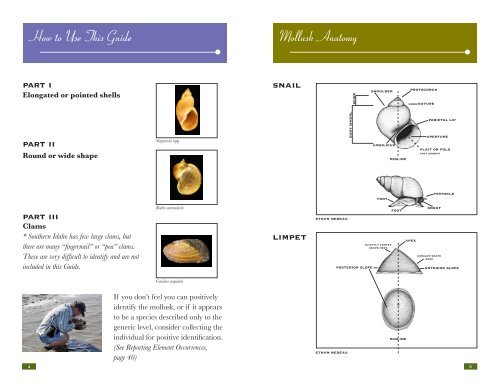Freshwater Mollusks - U.S. Fish and Wildlife Service
Freshwater Mollusks - U.S. Fish and Wildlife Service
Freshwater Mollusks - U.S. Fish and Wildlife Service
You also want an ePaper? Increase the reach of your titles
YUMPU automatically turns print PDFs into web optimized ePapers that Google loves.
How to Use This Guide<br />
part i<br />
Elongated or pointed shells<br />
part ii<br />
Round or wide shape<br />
part iii<br />
Clams<br />
* Southern Idaho has few large clams, but<br />
there are many “fingernail” or “pea” clams.<br />
These are very difficult to identify <strong>and</strong> are not<br />
included in this Guide.<br />
Stagnicola spp<br />
Radix auricularia<br />
Gonidea angulata<br />
If you don’t feel you can positively<br />
identify the mollusk, or if it appears<br />
to be a species described only to the<br />
generic level, consider collecting the<br />
individual for positive identification.<br />
(See Reporting Element Occurrences,<br />
page 40)<br />
Mollusk Anatomy<br />
snail<br />
limpet<br />
ethan nedeau<br />
ethan nedeau<br />
body whorl<br />
spire<br />
posterior slope<br />
shoulder<br />
umbilicus<br />
foot<br />
slightly convex<br />
shape here<br />
midline<br />
foot<br />
midline<br />
protoconch<br />
apex<br />
suture<br />
parietal lip<br />
aperture<br />
plait or fold<br />
(not shown)<br />
tentacle<br />
snout<br />
concave shape<br />
here<br />
anterior slope<br />
4 5

















